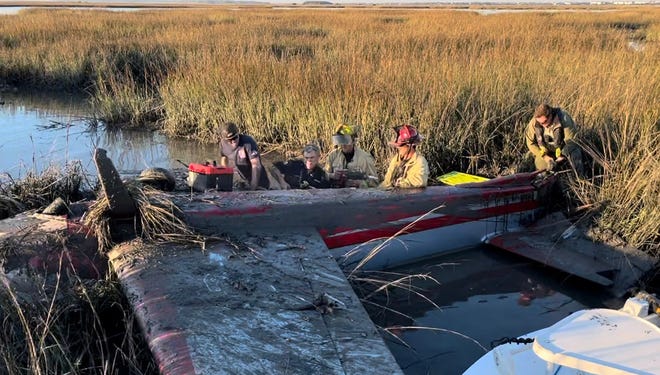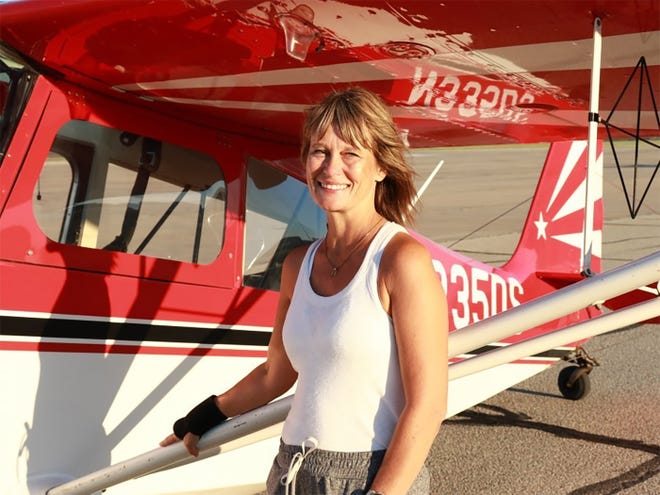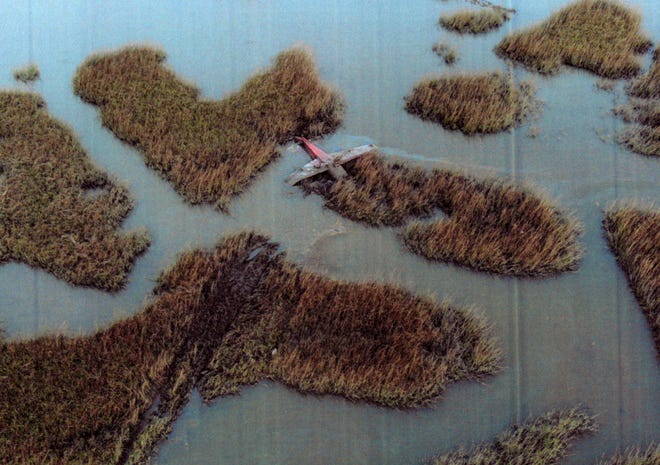Did Marianne Fox die a preventable death at St. Augustine Airport on March 2, 2022?
You tell me.
- Ms. Sherry Badger and her son were witnesses to the crash, heard Ms. Fox cry for help for some 25 minutes, and told an insouciant St. Johns County Commission about it at their March 15, 2022 meeting, after waiting around all day due to Commissioner JEREMIAH RAY BLOCKER's edict as Chair in 2021, putting non-agenda public comment at the very end of our meetings.
- Mind boggling to have no 24/7 firehouse at St. Augustine Airport, with intense use by both Northrop Grumman and private pilots, including those for oligarchs.
- Is the death of Ms. Marianne Fox the result of St. Augustine Airport Authority negligence -- a breach of the standard of care for airports?
- In the words of Ralph Nader's book about the auto industry, have management errors made our St. Augustine Airport "unsafe at any speed?"
- I look forward to NTSB hearings and investigations of the death of Marianne Fox at an "airport" with a 7000 foot runway, capable of landing Air Force One and milirtary planes, which is unadorned by a 24/7 firehouse.
- Airport Executive Director EDWARD WUELLNER gets tax-free rent use of his house at the airport, supposedly on the ground that he can respond to emergencies.
- In this event, the response time was 45 minutes.
- EDWARD WUELLNER's employment contract was written by controversialdeveloper lawyer DOUGLAS NELSON BURNETT of St. Johns Law Group, who has also represented WUELLNER in his personal capacity for a corporation he formed.
- IRS needs to investigate the Airport's tax treatment of WUELLNER's fringe benefits.
- Good investigative reporting by St. Augustine Record reporters Colleen Michele Jones and Sheldon Gardner:
Crews struggled to get to pilot in marsh after wreck at St. Augustine airport
Marianne Fox died after crashing, landing upside down

After wrecking an airplane into the marsh near the Northeast Florida Regional Airport on March 2, Marianne Fox was trapped in the upside-down vehicle for around 45 minutes.
Crews struggled to find her plane amid the marsh, and the tide rose as minutes ticked by. Fox, 49, of Oregon, died after she was transported to Flagler Hospital and then to UF Health Jacksonville, leaving behind family and friends to mourn. Her autopsy report has not been released, so the official cause of death has not been stated.
The crash is still under investigation by the National Transportation Safety Board, but officials from the airport and St. Johns County Fire Rescue said that the delay in getting aid to Fox was mostly caused by difficulty in locating and then accessing the plane in the marsh. A bystander, who is also a pilot, questioned aspects of the response and whether more could have been done faster to save Fox’s life.

In a March 17 post on Facebook, world-renowned aerobatics pilot Patty Wagstaff, who is based in St. Augustine, questioned how even if Fox had made a misjudgment in her landing, "Making a mistake at an airport should not have been a death sentence."
According to how officials described the accident, Fox wrecked in a bad place at a bad time.
‘A helpless feeling’
St. Johns County Airport Authority Executive Director Ed Wuellner spoke with The Record after viewing video from the scene and speaking with first responders and airport officials. He said some of the speculation about the wreck has been false.
The NTSB released its preliminary report this week. A final report will follow. The preliminary report detailed the sequence of events leading up to the crash as they're currently known. Some of the details about the incident vary among the different reporting agencies.
Fox and her fiancé, Jim Bourke, a fellow aerobatics pilot, were traveling in separate planes from Keystone Heights to St. Augustine.Bourke saw smoke coming from the exhaust of Fox's airplane. He checked with her over the radio about whether her smoke generator was on. Fox said it wasn't, and she said the engine was only producing 1,380 rpm, which is less than what would be expected at the 2,200 rpm cruise power setting.
About 10 miles west of the Northeast Florida Regional Airport, Bourke told air traffic control that Fox's plane had a partial loss of engine power and was trailing smoke. He declared an emergency. Fox said over the tower frequency, "My engine is doing something weird. What do I do?" As they approached the airport, Bourke was heard over the tower frequency saying, "You're going to make it down. Cut the throttle. Slip it in. You have a lot of energy now. Cut the throttle. Slip it deep ― deep, slip. You got it."
As the airplane crossed the airport boundary, it was about 200 feet off the ground and traveling at about 165 knots groundspeed. The airplane overflew the 8,000-foot runway and came to rest upside down in marshland about 1,500 feet past the departure end of the landing runway at about 5:02 p.m.
Afterward, Fox was heard saying over the tower frequency, “I had too much speed. I should have come in slower.”
Examination of the wreckage revealed no evidence of in-flight or post-crash fire.
The initial mechanical review found that "the fuel appeared clear and free of contaminants. Two of the three propeller composite blades were fractured off at the hub. The engine’s crankshaft was rotated by hand at the propeller hub and continuity was established from the powertrain to the valvetrain and the accessory section. Compression was confirmed using the thumb method. Examination of the cylinders, valves and pistons with a lighted borescope revealed no anomalies. Both magnetos were removed, actuated with an electric drill, and spark was produced at all terminal leads. The propeller governor was removed, rotated by hand, and oil flowed through the governor as designed. The mechanical fuel pump was removed and pumped fluid when actuated by hand; no anomalies were noted. The electric fuel pump operated normally with electrical power applied; the pump rotated normally. The throttle body fuel filter, fuel nozzles, and fuel flow divider were clear and free of debris."

Wuellner said crews did not know where Fox's plane was after she crashed.
"The area that they were having to attempt to find this airplane is pretty expansive just to see," he said. "There's no outward evidence that where the airplane would be, meaning there's no smoke or fire or something that's, you know, clearly pointing to a location."
Fire rescue crews responded from a nearby station within about five minutes of getting a call, Wuellner said. Other emergency vehicles and agencies arrived soon after.
The airport has a fire station on site, but it was not staffed at the time. The Federal Aviation Administration requires it to be staffed during times of day when flights with the airport's commercial service, Elite Airways, are scheduled, but Fox’s plane came in outside of that time frame, Wuellner said. During flight hours, the crew on site must be able to respond within two minutes, so the responding crew wasn’t far behind that mark, he said.
St. Johns County Fire Rescue reported that responders arrived on scene at the airport at 5:05 p.m.; they reached Fox at 5:44 p.m.
Some have said fire rescue was delayed because they didn’t have access to the site, but firefighters have a key to the gate for emergencies and it opened smoothly, according to Wuellner.

It took maybe 10 minutes longer, Wuellner estimated, for sheriff’s office personnel trained to drive the airboat to arrive. The St. Johns County Sheriff’s Office also used drone technology in trying to locate the plane. Authorities used multiple boats and pieces of equipment to try and locate Fox and get her out of the plane.
A bystander who happened to be in the marsh in a boat at the time of the crash helped direct search crews to the plane, Wuellner said.
St. Johns County Fire Rescue spokesman Jeremy Robshaw described the rescue effort to The Record:
"Once arriving with the patient, crews were able to extricate her in approximately four (minutes). They did have to utilize heavy extrication tools during part of the extrication.
"As for the time required to get to her, this was a challenging patient access due to her location which was approximately 600 yards into the marsh from the end of the runway with the plane upside down and not visible to the tower or responding rescue crews.
"Unfortunately due to the location of the wreck, access by foot was not feasible and crews had to utilize the airport's airboat to gain patient access. The boat was needed to transport the firefighters and all the equipment required for the potential extrication.
"Even utilizing the airboat, the plane itself was difficult to locate and gain access to due to the marsh/mud and tidal elevations that limited visibility and access to the scene."
Wuellner was among the officials at the scene.
"It's the most helpless feeling standing there watching the whole thing go down," he said.

'You start to panic'
For Wagstaff, the situation also brought back horrible memories of her own crash at the St. Augustine airport two years ago.
Wagstaff, who has a hangar on airport property, was coming in for a landing when she hit a berm, flipping the plane onto its back in a grassy area just off the runway.
Pinned upside down into the pilot's compartment, Wagstaff remembers how disoriented she felt, the world a blur around her.
"You start to panic and then say, 'No, don't do that, get out,'" said Wagstaff.
Thankfully, about 10 minutes later, she and her passenger were able to climb out an emergency window to safety.
"We were very lucky," she said.
Lucky, Wagstaff said, because according to her, no one came to their rescue.
She said she wrote a letter to airport officials expressing her concern over a lack of safety protocols but, to her knowledge, nothing changed after the incident.
Wagstaff knew Fox from the stunt pilot circuit and is still reeling from the tragedy.
"She was cool, friendly, no nonsense and could fly the hell out of an airplane," said Wagstaff.
Airport safety in St. Augustine
Wuellner said that the airport is not a first-responder agency but is a resource for first responders. Still, the airport looks at how to improve measures after every incident.
It's not the first time a plane has wrecked in the marsh, though those incidents are rare, Wuellner said. Walking in the marsh is very difficult or impossible without special equipment, and even then it takes a long time. The airport added an airboat in recent years to help navigate the marsh.
Airport Operations Manager Kevin Harvey said there was a wreck several years ago in the marsh before the airport had the airboat.
"Fire rescue had to go out with their mud boots and sticks and all that, put them on sleds and drag them back," he said.
Harvey said that's when they decided to get an airboat.
One idea to improve safety is to have the on-site fire station staffed continually instead of only during scheduled flight hours. The airport has begun to work with the county to see if that can be done, Wuellner said.

Wuellner said the airport follows all Federal Aviation Administration regulations, including safety protocols for the layout of the airport and in preparing for emergencies. Throughout the year, the airport helps fire rescue personnel understand the airport, its layout and operations, he said. Fire rescue officials also regularly train on how to respond to an airplane wreck.
"It's always tragic. But if you put it in context, every other airport in the country has largely some obstacle … and I'm not trying to paint an ugly picture here, but, I mean, the other end would be trees, would be a railroad, would be U.S. 1," he said. "I'm not sure the results end up any better. If you can't control the aircraft and end up crashing into a stand of trees, it's a low probability of survival there, too."
With the wreck still under investigation, St. Johns County Fire Rescue has not yet had discussions on how to potentially improve response times at the airport, according to Robshaw.
"The NTSB is conducting a review of the incident and will develop a report and potentially some recommendations," according to Robshaw. "At this point we are limited in what we can say as the review/investigation is still underway and we don't want to interfere with that process."
No comments:
Post a Comment